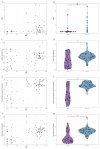A Protocol for Low-Input RNA-Sequencing of Patients with Febrile Neutropenia Captures Relevant Immunological Information
- PMID: 37373397
- PMCID: PMC10299151
- DOI: 10.3390/ijms241210251
A Protocol for Low-Input RNA-Sequencing of Patients with Febrile Neutropenia Captures Relevant Immunological Information
Abstract
Improved methods are needed for diagnosing infectious diseases in children with cancer. Most children have fever for other reasons than bacterial infection and are exposed to unnecessary antibiotics and hospital admission. Recent research has shown that host whole blood RNA transcriptomic signatures can distinguish bacterial infection from other causes of fever. Implementation of this method in clinics could change the diagnostic approach for children with cancer and suspected infection. However, extracting sufficient mRNA to perform transcriptome profiling by standard methods is challenging due to the patient's low white blood cell (WBC) counts. In this prospective cohort study, we succeeded in sequencing 95% of samples from children with leukaemia and suspected infection by using a low-input protocol. This could be a solution to the issue of obtaining sufficient RNA for sequencing from patients with low white blood cell counts. Further studies are required to determine whether the captured immune gene signatures are clinically valid and thus useful to clinicians as a diagnostic tool for patients with cancer and suspected infection.
Keywords: febrile neutropenia; low-input RNA-sequencing; neutropenia; paediatrics; transcriptomics; white blood cells.
Conflict of interest statement
The authors declare no conflict of interest.
Figures







References
-
- Castagnola E., Fontana V., Caviglia I., Caruso S., Faraci M., Fioredda F., Garrè M.L., Moroni C., Conte M., Losurdo G., et al. A Prospective Study on the Epidemiology of Febrile Episodes during Chemotherapy-Induced Neutropenia in Children with Cancer or after Hemopoietic Stem Cell Transplantation. Clin. Infect. Dis. 2007;45:1296–1304. doi: 10.1086/522533. - DOI - PubMed
-
- Lehrnbecher T., Averbuch D., Castagnola E., Cesaro S., Ammann R., Garcia-Vidal C., Kanerva J., Lanternier F., Mesini A., Mikulska M., et al. 8th European Conference on Infections in Leukaemia: 2020 guidelines for the use of antibiotics in paediatric patients with cancer or post-haematopoietic cell transplantation. Lancet Oncol. 2021;22:e270–e280. doi: 10.1016/S1470-2045(20)30725-7. - DOI - PubMed
-
- Caselli D., Cesaro S., Fagioli F., Carraro F., Ziino O., Zanazzo G., Meazza C., Colombini A., Castagnola E. Infectious Diseases Study Group of the Italian Association of Pediatric Hematology and Oncology (AIEOP) Incidence of colonization and bloodstream infection with carbapenem-resistant Enterobacteriaceae in children receiving antineoplastic chemotherapy in Italy. Infect. Dis. 2015;48:152–155. doi: 10.3109/23744235.2015.1087647. - DOI - PubMed
MeSH terms
Substances
Grants and funding
LinkOut - more resources
Full Text Sources
Medical

